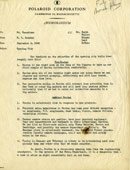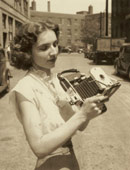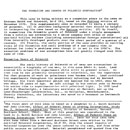Polaroid Corporation Records at Baker Library, Harvard Business School
The Polaroid Corporation Records at Baker Library detail the history of one of the 20th century's most innovative, creative, and successful corporations. The collection's size, approximately 4,000 linear feet, and variety afford a remarkably comprehensive view of the inner workings of an iconic company.
As this exhibit opens, approximately 65 percent of the Polaroid Corporation collection is available for research use. Processing and cataloging of the remaining materials continues; these records will be opened for research as the work is completed.
The Polaroid Corporation Administrative Records document the management and leadership of the company, its efforts to present itself and its products to consumers, and work life and employee-management relations at Polaroid. The records include corporate governance documents, such as board of directors meeting minutes, operating policy committee records, and stockholder annual meeting files, as well as public relations and communications records and human resources and personnel management documents.
The Polaroid Corporation Legal and Patent Records document the company's rigorous efforts to register patents for its inventions, products, and technological innovations and to protect its intellectual property from patent and trademark infringement. The records include papers of Polaroid's legal department and attorneys, patent application files, and supporting materials. There is also extensive documentation of Polaroid's efforts to defend its patent and trademark rights, most notably in its lawsuit against Eastman Kodak during the 1980s and 1990s.
The Polaroid Corporation Research and Development Records document the work of the scientists, engineers, and designers who conceived, built, and perfected Polaroid's innovative products, especially the iconic Polaroid Land instant camera. The records include the papers of many of the men and women responsible for Polaroid's inventions and advances, such as its early polarizers during the 1930s, the initial development of instant photography in the 1940s, and the invention of color instant film in the 1950s.
Annual corporate reports can be one of the most valuable resources in studying the history of a company. The Polaroid Corporation Records include a set of the company's annual reports from 1946 to 2000. Polaroid's annual reports typically include a letter to shareholders written by Edwin H. Land, a review of the year's research efforts, manufacturing operations, new product development, advertising and marketing strategies, and year-end financial statements.
Polaroid Corporation Photographs
As a manufacturer of photographic goods for consumers, the Polaroid Corporation itself necessarily created millions of photographs during the design and marketing of its products. The collection contains a remarkably comprehensive set of these photographs, in Polaroid's various instant film formats and in many non-Polaroid formats. These include prototype and test photographs created as the company developed new instant film products, from the breakthrough Type 40 film of the 1940s to color Spectra film of the 1980s. There are also photographs of Polaroid products, and models posing with them, taken for advertising and marketing campaigns. The photographs include images of Polaroid employees at work in the company's laboratories, offices, and manufacturing facilities. The photograph series will open for research use when cataloging is completed.
Polaroid Corporation Audiovisual Materials
The Polaroid Corporation Records include an extensive collection of audiovisual materials in many different formats, from film to audiotape to DVD, that date from the 1940s to the 2000s. The recordings include commercials created for Polaroid products, annual shareholder meeting recordings, new product launches, and employee training films. The collection contains more than 2,000 items. A collection inventory is available.
Polaroid Corporation Products
Included in the Polaroid Corporation Records are select examples of the company's products, such as Polaroid's 1930s desk lamps, World War II-era goggles and sunglasses, and Polaroid Land cameras from the 1940s to the 2000s. The collection also includes a large selection of Polaroid's product packaging designed for its film and cameras.
HBS Archives
The HBS Archives collects, organizes, preserves, and provides access to the records of Harvard Business School from its founding in 1908 through the current day. The Archives are a rich resource to learn about the development of the case method, changes in the Harvard Business School curriculum, the intersection of HBS and innovations in business, and the global impact of HBS.
Faculty Research Collections provide insight into the evolution and impact of business theory and education. HBS faculty have been leaders in developing new areas of research and applying theoretical frameworks in and outside of the classroom. Faculty research collections contain case preparation materials and drafts, course syllabi, research data, lecture and seminar notes, and professional correspondence as well as company records that served as subjects for research. Included in At the Intersection of Science and Art: Edwin H. Land and the Polaroid Corporation — The Formative Years are resources from the collections of Professors J. Keith Butters and John G. McLean.
Retired Case Collection
Instituted in 1921, the case method continues to be a cornerstone of the HBS academic experience. The HBS Archives holds more than fifty thousand retired cases used for teaching at HBS from the 1920s through the current day. These cases offer insight into the challenges facing companies and include historic and statistical data.
The HBS Archives Photograph Collection includes an extensive collection of more than ten thousand images that depict the Harvard Business School community, campus, and major events. Photographs illustrate faculty teaching, MBA and Executive Education students the classroom and engaging in social events, visitors to campus, and historic images of HBS buildings and grounds.











